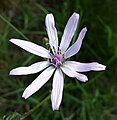Red salsify
| Red salsify | ||||||||||||
|---|---|---|---|---|---|---|---|---|---|---|---|---|

Red salsify ( Podospermum purpureum ), illustration |
||||||||||||
| Systematics | ||||||||||||
|
||||||||||||
| Scientific name | ||||||||||||
| Podospermum purpureum | ||||||||||||
| ( L. ) WDJ Koch & Ziz |
The red salsify ( Podospermum purpureum (L.) WDJ Koch & Ziz , Syn .: Scorzonera purpurea L. ), also known as purple salsify , red-flowered salsify or violet salsify , is a plant species of the sunflower (Asteraceae ) that can be found in Central Europe ). Inside it contains a white, slightly greenish, milk-like liquid. It belongs to the subfamily of the Cichorioideae .
description
The red salsify is a herbaceous plant that is one to two years old and reaches a height of between 20 and 50 cm. The upright growing simple or branched, mostly bald to slightly woolly hairy stems are shaped like a handle and only finely grooved in the upper part. The leaves , up to 20 cm long, are divided into pinnate sections down to the median nerve and have distant, pointed, linear-lanceolate sections. These are usually around 2 to 3 mm wide and 10 to 25 mm long.
The approximately 30 mm wide, cup-shaped inflorescences grow individually on long stems . The outer bracts are egg-shaped and have a bent back tip, the inner ones are mostly more or less blunt. At the time of flowering, the cover reaches a length of up to 15 mm, after flowering it can be up to 40 mm long. The flower heads consist of purple to pale lavender ray- flowers that reach about the length of the envelope. The flowers smell like cocoa . The flowering period extends from May to June.
The number of chromosomes is 2n = 14.
Location claims and distribution
The red salsify prefers warm, dry, base-rich, mostly calcareous, humus-rich black earth-like gravel, sand or gypsum soils. It is a character species of the Adonido-Brachypodietum from the Cirsio-Brachypodion association, but is also found less often in companies of the Festucion valesicae association. It is often only inconsistent or is occasionally carried off.
The distribution area includes France, Italy, Germany, the Czech Republic, Austria, the Balkan Peninsula, Bulgaria, Poland, Hungary, Slovakia, Moldova, Romania, Ukraine and Russia. In Central Europe, the species hardly crosses the wine-growing areas . In Germany the species occurs rarely and partly inconsistently in the western, central and southwestern areas.
In Austria, the purple salsify occurs scattered or rarely in the Pannonian area of the federal states of Vienna , Lower Austria and Burgenland .
ecology
The red salsify is light-loving and deep-rooted. Its flowers, pollinated by insects, are open until morning.
Systematics
According to Euro + Med, the two taxa Podospermum purpureum and Podospermum roseum (Waldst. & Kit.) Gemeinholzer & Greuter can be summarized as one species under the name Podospermum purpureum (L.) WDJ Koch & Ziz . This also includes the taxon Podospermum roseum subsp. peristericum (Formánek) Gemeinholzer & Greuter . It occurs only in Greece and Macedonia. Podospermum roseum is found in Italy, Austria, Slovenia, Croatia, Serbia, Montenegro, Bosnia-Herzegovina, Albania, Macedonia, Greece, Bulgaria, Romania, Poland, Slovakia and the Ukraine.
Hazard and protection
The species is considered endangered in Central Europe. In Germany it is listed as critically endangered on the Red List of Endangered Plants. It is strictly protected according to the Federal Species Protection Ordinance (BArtSchV). In some locations, such as the Großer Sand in Mainz, it is threatened with extinction. The habitats of the red salsify are continental dry grass and semi-dry grass communities. These are listed as priority habitats in the EU Habitats Directive. They are of European nature conservation value.
In Austria the species is considered endangered.
literature
- Henning Haeupler , Thomas Muer: picture atlas of the fern and flowering plants of Germany (= the fern and flowering plants of Germany. Volume 2). Published by the Federal Agency for Nature Conservation. Ulmer, Stuttgart 2000, ISBN 3-8001-3364-4 .
- Erich Oberdorfer : Plant-sociological excursion flora. Ulmer, Stuttgart, 1994, ISBN 3-8252-1828-7
- Siegmund Seybold : Schmeil-Fitschen . Flora of Germany and neighboring countries. A book for identifying vascular plants that grow wild and often cultivated . 93rd, completely revised and expanded edition. Wiebelsheim (Quelle & Meyer Verlag), 2006, ISBN 3-494-01413-2
Individual evidence
- ^ A b c Manfred A. Fischer, Karl Oswald, Wolfgang Adler: Excursion flora for Austria, Liechtenstein and South Tyrol . 3rd, improved edition. Province of Upper Austria, Biology Center of the Upper Austrian State Museums, Linz 2008, ISBN 978-3-85474-187-9 , p. 958 .
- ↑ a b c Erich Oberdorfer : Plant-sociological excursion flora for Germany and neighboring areas . With the collaboration of Angelika Schwabe and Theo Müller. 8th, heavily revised and expanded edition. Eugen Ulmer, Stuttgart (Hohenheim) 2001, ISBN 3-8001-3131-5 , pp. 982 .
- ↑ a b c Werner Greuter (2006+): Compositae (pro parte majore). - In: W. Greuter & E. von Raab-Straube (ed.): Compositae. Euro + Med Plantbase - the information resource for Euro-Mediterranean plant diversity. Datasheet Podospermum purpureum In: Euro + Med Plantbase - the information resource for Euro-Mediterranean plant diversity.
Web links
- Scorzonera purpurea. In: FloraWeb.de.
- Distribution in Germany
- Red salsify . In: BiolFlor, the database of biological-ecological characteristics of the flora of Germany.
- Profile and distribution map for Bavaria . In: Botanical Information Hub of Bavaria .
- Thomas Meyer: Black salsify data sheet with identification key and photos at Flora-de: Flora von Deutschland (old name of the website: Flowers in Swabia )



